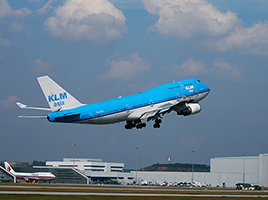By the time of this incident, the dangers of flying through volcanic ash were well known. A similar incident happened with another Boeing 747 about seven years previous, see British Airways 9.
— James Albright

Updated:
2012-01-01

PH-BFC, from Creative Commons.
Volcanic ash detection was still difficult, it is a dry powder and does not show up on radar. As with the earlier incident, the ash fouled the engines causing them to shut down. Once the airplane descended to lower altitudes the ash collected on the turbine blades cooled and broke off, allowing the engines to relight. This crew did the best they could given the information they had, but they could have done one thing better after the encounter: reduce thrust, not increase. See: Volcanic Ash.

1
Accident report
- Date: 15 December 1989
- Time: 11:48
- Type: Boeing 747-406
- Operator: KLM Royal Dutch Airlines
- Registration: PH-BFC
- Fatalities: 0 of 14 crew, 0 of 231 passengers
- Aircraft Fate: Repaired
- Phase: En route
- Airport: (Departure) Amsterdam-Schiphol International Airport (AMS/EHAM), Netherlands
- Airport: (Destination) Anchorage International Airport, AK (ANC/PANC), United States of America
2
Narrative
BFR TKOF, CREW OF KLM FLT 867 ADZD OF VOLCANIC ERUPTION ABT 100 MI SW OF DESTN. EN ROUTE, FLT ADZD OF ANOTHER ERUPTION. FOR ARR, FLT CLRD TO DSCND FM FL 390 AT PLT'S DISCRETION; VCTR GIVEN TO AVOID LAST KNOWN AREA OF ASH CLD. DRG DSCNT THRU FL 260, FLT ENCTRD ASH CLD; ASH/SMOKE ENTERED COCKPIT/CABIN. CREW DONNED O2 MASKS; USED MAX PWR TO CLB. 1 MIN LTR, ALL ENGS LOST PWR (TO 28%-30% RPM); THERE WAS ELEC PWR INTRPN, LOSS OF AIRSPD INDCN, FIRE WARNING ALARM FOR FWD CARGO AREA. AFTER 8-9 ATMTS & DSCNT TO 13,300', ALL ENGS RESTARTED & FLT CONTD TO SAFE LDNG.
Source: NTSB Report
3
Analysis
DMG FND ON EXTERNAL SFCS OF ACFT & IN HI PRES TURBINES OF ALL ENGS. BOEING OMB #747-B2-4, ADZD TO AVOID VOLCANIC ACTIVITY; BUT IF ENCTRD, RETARDING THRUST TO IDLE WLD RDC BLDUP IN ENG & IMPROVE STALL MARGIN. ATC RADAR COULD ONLY DETECT VOLCANIC ASH FOR 5-10 MIN AFTER ERUPTION; ACFT RADAR NOT DESIGNED TO DETECT ASH. ASH CLD FCST TO MOV NNE AT 60 KTS; REVIEW OF SATELLITE DATA SHOWED IT ACTUALLY MOVED AT ABT 120 KTS. KLM HAD NO PROC FOR 747 ENCTR WITH ASH CLD & NO ADNL INSTRNS WERE GIVEN TO KLM CREWS.
Source: NTSB Report
4
Cause
INADVERTENT ENCOUNTER WITH VOLCANIC ASH CLOUD, WHICH RESULTED IN DAMAGE FROM FOREIGN MATERIAL (FOREIGN OBJECT) AND SUBSEQUENT COMPRESSOR STALLING OF ALL ENGINES. A FACTOR RELATED TO THE ACCIDENT WAS: THE LACK OF AVAILABLE INFORMATION ABOUT THE ASH CLOUD TO ALL PERSONNEL INVOLVED.
Source: NTSB Report
References
(Source material)
NTSB Record of Incident, ANC90FA020, KLM Royal Dutch Airlines, December 15, 1989 in Anchorage, AK